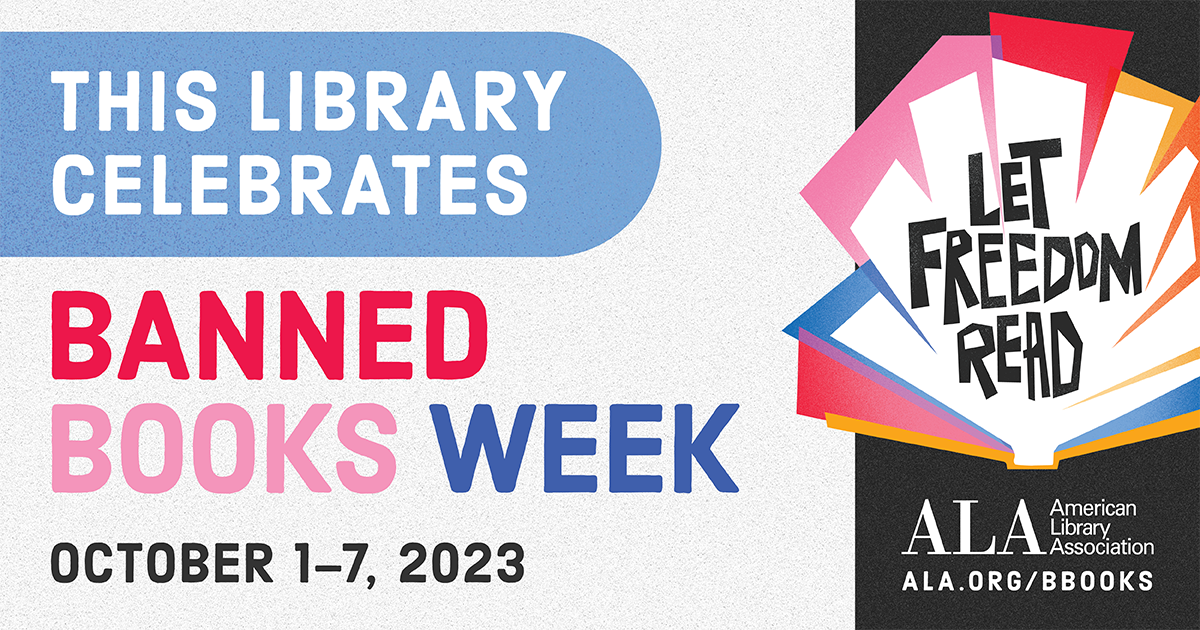 “If all printers were determined not to print anything till they were sure it would offend nobody, there would be very little printed.” ― Benjamin Franklin, Founding Father of the United States
“If all printers were determined not to print anything till they were sure it would offend nobody, there would be very little printed.” ― Benjamin Franklin, Founding Father of the United States
Banned Books Week is upon us once again: October 1-7. The theme chosen this year by the American Library Association (ALA) is “Let Freedom Read” with the slogan “Free People Read Freely.” I love this theme. I love freedom. And really, who doesn’t? Some of our greatest leaders have supported the idea of the freedom to read. President Dwight D. Eisenhower gave a commencement address at Dartmouth University on June 14, 1953 in which he said “Don’t join the book burners. Don’t think you’re going to conceal faults by concealing evidence that they ever existed. Don’t be afraid to go in [sic] your library and read every book…” And from across the aisle, upon signing the amendment to the Library Services Act February 11, 1964, Lyndon B Johnson said “The central fact of our times is this: Books and ideas are the most effective weapons against intolerance and ignorance.”
It’s been a rough year for libraries, schools, publishers and readers. According to the ALA’s Office for Intellectual Freedom (OIF), 2022 saw the highest level of book bans in over 20 years.There has been a 68% increase since 2021 in attempts of censorship with an increase in the number of titles targeted by 38%. They report that, “Most censorship cases go unreported so our data represents only a snapshot of what is taking place.” The ALA defines “censorship” as “any act limiting access to expressions or ideas based on the belief that they are objectionable or dangerous.”
There is also a rise in censorial legislation as well as direct attacks on librarianship across the country such as Missouri SB 775 which went into effect on August 28, 2023. The new law criminalizes “providing explicit sexual material to a student if such person is affiliated with a public or private elementary or secondary school in an official capacity…” as a Class A misdemeanor without defining what is meant by “explicit sexual material.” According to PEN America, a nonprofit group of poets, essayists and novelists that have been tracking American censorship since 1922, “Of the 1,477 reported book ban cases this school year (July-December, 2022), 74% are connected to organized efforts, mainly of advocacy groups; elected officials;
or enacted legislation.” We also saw a steep rise in multiple title challenges by pressure groups against LGBTQIA+, EDI (equity, diversity and inclusion) and perceived CRT (Critical Race Theory)
titles and authors, often without the books being read. Lists of books to be banned made up 90% of the challenges and, of those, 40% of them contained more than 100 titles within a single challenge. Banned book lists of over 100 titles is a brand new thing. It had never happened before 2021.
The Supreme Court and other courts have made clear that the First Amendment includes protections for individuals and society at large from government attempts to suppress ideas and information including the censorship of books, magazines, newspapers, art, film, music and information on the internet. Justice William Brennan wrote in 1965:
”I think the right to receive publications is such a fundamental right. The dissemination of ideas can accomplish nothing if otherwise willing addressees are not free to receive and consider them. It would be a barren marketplace of ideas that had only sellers and no buyers.” Lamont v. Postmaster General, 381 U.S. 301 (1965)
And once upon a time, when a school district tried to remove “Catch-22”, “God Bless You, Mr. Rosewater”, and “Cat’s Cradle,” the 6th Circuit Court found that the First Amendment protects the right of students to receive information and that a decision to remove the books from the school library was unconstitutional in the case Minarcini v. Strongsville (Ohio) City School District, 541 F.2d 577 (6th Cir. 1976). That is not to say that parents don’t have the right to choose what their children consume, but neither they nor the government have the right to make that choice for other parents or society at large.
Potter Stewart, an Associate Justice of the Supreme Court, said, “Censorship reflects a society’s lack of confidence in itself. It is a hallmark of an authoritarian regime,” in his dissent to Ginzburg v. United States, 383 U.S. 463 (1966).
You can help fight against threats to the freedom to read by joining the ALA’s effort through Unite Against Book Bans. Pictured throughout this post are the 13 most frequently challenged titles. You can find a list of more banned books here. I hope you will join us in celebrating your freedom to read.


